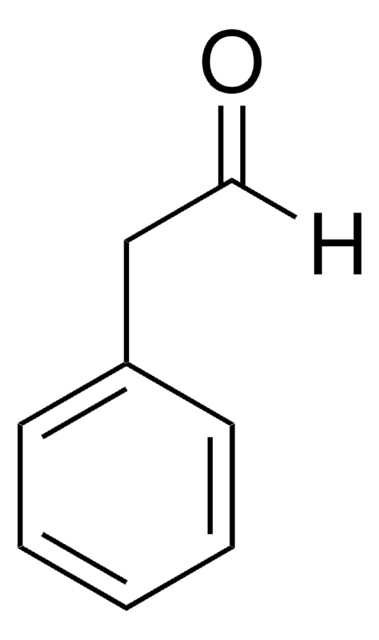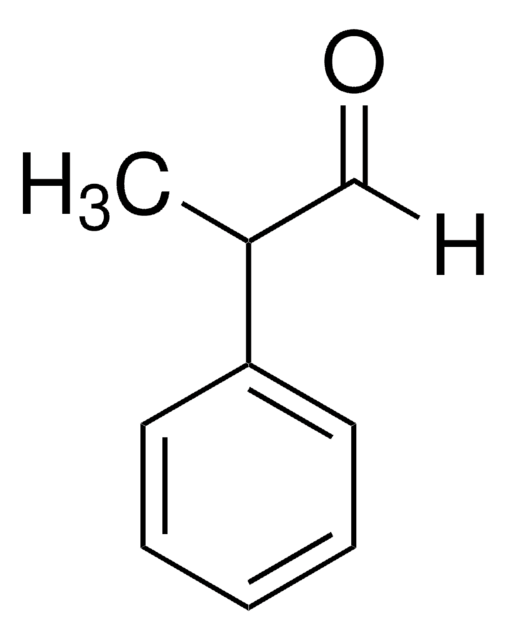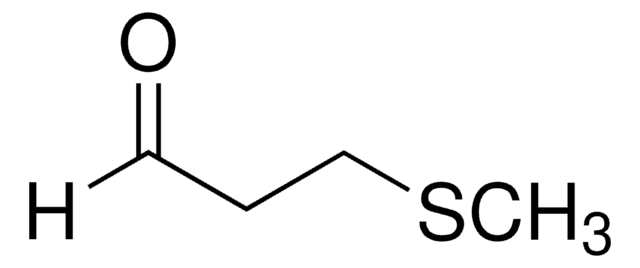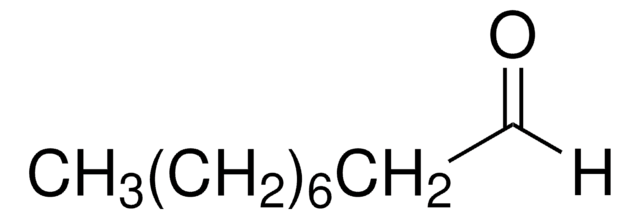Wichtige Dokumente
W287407
Phenylacetaldehyd
≥95%, FCC, FG
Synonym(e):
α-Tolyaldehyd
About This Item
Halal
Kosher
Empfohlene Produkte
Biologische Quelle
synthetic
Qualitätsniveau
Qualität
FG
Halal
Kosher
Agentur
meets purity specifications of JECFA
Einhaltung gesetzlicher Vorschriften
EU Regulation 1334/2008 & 178/2002
FCC
FDA 21 CFR 172.515
Beschreibung
may contain Citric acid
Assay
≥95%
Brechungsindex
n20/D 1.535 (lit.)
bp
195 °C
mp (Schmelzpunkt)
−10 °C (lit.)
Dichte
1.035 g/mL at 25 °C
Anwendung(en)
flavors and fragrances
Dokumentation
see Safety & Documentation for available documents
Nahrungsmittelallergen
no known allergens
Organoleptisch
chocolate; green; honey; hyacinth
Lagertemp.
2-8°C
SMILES String
O=CCc1ccccc1
InChI
1S/C8H8O/c9-7-6-8-4-2-1-3-5-8/h1-5,7H,6H2
InChIKey
DTUQWGWMVIHBKE-UHFFFAOYSA-N
Suchen Sie nach ähnlichen Produkten? Aufrufen Leitfaden zum Produktvergleich
Allgemeine Beschreibung
Biochem./physiol. Wirkung
Sonstige Hinweise
Signalwort
Danger
H-Sätze
Gefahreneinstufungen
Acute Tox. 4 Oral - Aquatic Chronic 3 - Eye Dam. 1 - Skin Corr. 1B - Skin Sens. 1A
Lagerklassenschlüssel
8A - Combustible corrosive hazardous materials
WGK
WGK 1
Flammpunkt (°F)
154.4 °F - (External MSDS)
Flammpunkt (°C)
68 °C - (External MSDS)
Persönliche Schutzausrüstung
Eyeshields, Faceshields, Gloves, type ABEK (EN14387) respirator filter
Hier finden Sie alle aktuellen Versionen:
Besitzen Sie dieses Produkt bereits?
In der Dokumentenbibliothek finden Sie die Dokumentation zu den Produkten, die Sie kürzlich erworben haben.
Kunden haben sich ebenfalls angesehen
Protokolle
Unser Team von Wissenschaftlern verfügt über Erfahrung in allen Forschungsbereichen einschließlich Life Science, Materialwissenschaften, chemischer Synthese, Chromatographie, Analytik und vielen mehr..
Setzen Sie sich mit dem technischen Dienst in Verbindung.














